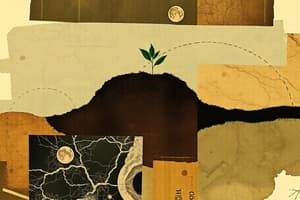Podcast
Questions and Answers
What is the primary composition of soil?
What is the primary composition of soil?
- Water and air
- Decaying plant and animal remains
- Sand, silt, and clay particles
- Minerals and organic matter (correct)
Which of the following is a type of soil erosion caused by the movement of air?
Which of the following is a type of soil erosion caused by the movement of air?
- Ice erosion
- Glacial erosion
- Wind erosion (correct)
- Water erosion
Which method of soil conservation involves planting different crops in alternating seasons?
Which method of soil conservation involves planting different crops in alternating seasons?
- Cover crops
- Grassed waterways
- Terracing
- Crop rotation (correct)
Why is soil testing important for agriculture?
Why is soil testing important for agriculture?
Which factor does NOT affect soil fertility?
Which factor does NOT affect soil fertility?
What role does organic matter play in soil composition?
What role does organic matter play in soil composition?
Why is soil testing important for farmers?
Why is soil testing important for farmers?
Which method helps reduce soil erosion and improve soil structure?
Which method helps reduce soil erosion and improve soil structure?
What is one factor that influences soil fertility?
What is one factor that influences soil fertility?
How does soil organic matter contribute to soil fertility?
How does soil organic matter contribute to soil fertility?
What can help detect nutrient deficiencies in the soil?
What can help detect nutrient deficiencies in the soil?
Which conservation method can help protect the soil?
Which conservation method can help protect the soil?
Flashcards are hidden until you start studying
Study Notes
Soil Resources: A Comprehensive Look
Soil is a dynamic and complex natural resource, essential to life above and below ground. This resource is composed of mineral particles, organic matter, water, and air, held together by a web of organic and inorganic substances. Let's delve into the various aspects that make soil a fascinating and irreplaceable element of our planet.
Composition of Soil
Soil is a heterogeneous mixture that contains mineral and organic components. Minerals make up about 45% of the soil, primarily composed of sand, silt, and clay particles. Organic matter, such as decaying plant and animal remains, constitutes approximately 5% of the soil, providing nutrients and improving its structure. Water and air occupy the remaining spaces, allowing plant growth and the activity of soil organisms.
Types of Soil Erosion
Soil erosion is the transport and redistribution of soil due to various natural processes, such as water, wind, and ice. Water erosion can occur through surface runoff and streambank erosion, while wind erosion is driven by the movement of air. Ice erosion, on the other hand, is caused by the expansion of water as it freezes, which can dislodge and transport soil particles.
Methods of Soil Conservation
Soil conservation is the practice of managing soil resources to protect their quality and productivity. This can be achieved through various techniques, such as crop rotation, contour farming, cover crops, terracing, and grassed waterways. Other practices, like agroforestry and conservation tillage, help reduce soil erosion and improve soil structure.
Importance of Soil Testing
Soil testing is a vital tool for determining the nutrient status and physical properties of the soil. This information helps farmers understand the soil's fertility, allowing them to apply the appropriate amount of fertilizers and amendments to optimize crop growth. Soil testing is also essential for monitoring soil health and detecting nutrient deficiencies or imbalances.
Factors Affecting Soil Fertility
Soil fertility is influenced by several factors, including soil organic matter, soil texture, nutrient availability, and soil pH. Soil organic matter is essential for providing nutrients, water-holding capacity, and improving soil structure. Soil texture, on the other hand, determines the soil's ability to hold water and nutrients, while soil pH impacts the availability of essential nutrients for plant growth.
In conclusion, soil is a critical resource that sustains life on Earth. Understanding its composition, types of erosion, conservation methods, testing, and factors affecting fertility is vital for managing our planet's natural resources in a sustainable way. By implementing best practices and striving to protect our soil, we can ensure the continuous production of food and other valuable resources.
Studying That Suits You
Use AI to generate personalized quizzes and flashcards to suit your learning preferences.




